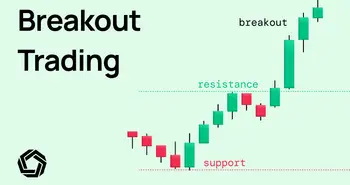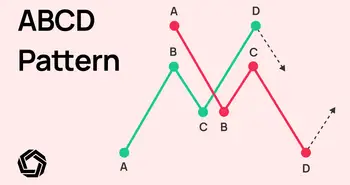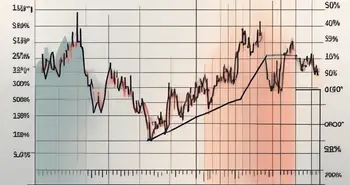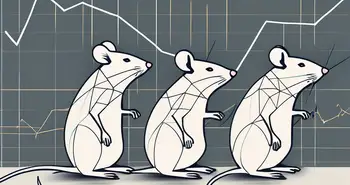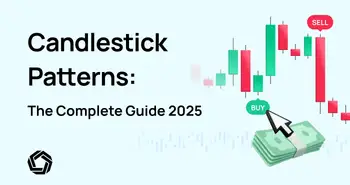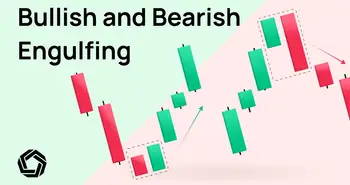Supertrend Indicator Strategy Ideas

The Supertrend Indicator is a straightforward yet powerful tool for spotting market trends, making it a favorite among traders of all levels. This guide breaks down everything you need to know—how it works, how to use it, and most importantly, how to turn it into actionable strategies. We’ll also include real-world examples so you can start applying what you learn right away. If you prefer to dive straight into the strategies, feel free to skip ahead using the outline, but we recommend that you start with the basics first to have the full picture.
Quick Snapshot: Supertrend Indicator
- The Supertrend Indicator identifies market trends: Bullish when price is above the line, Bearish when below.
- Customize settings (ATR and Multiplier) to balance signal frequency and reliability, and pair with tools like RSI, MACD, or candlestick patterns for stronger strategies.
- Buy: Price crosses above the line. Sell: Price crosses below.
What is the Supertrend Indicator?
The Supertrend Indicator is a technical analysis instrument designed to assist traders in discerning the prevailing market trend. Its significance lies in its ability to distinguish between bullish and bearish market conditions:
- Bullish Trend: This is indicated when the price trades above the Supertrend Indicator. In such scenarios, traders can consider long-biased opportunities.
- Bearish Trend: Conversely, when the price trades below the indicator, it hints at a bearish market scenario. Here, traders might look at potential short opportunities.
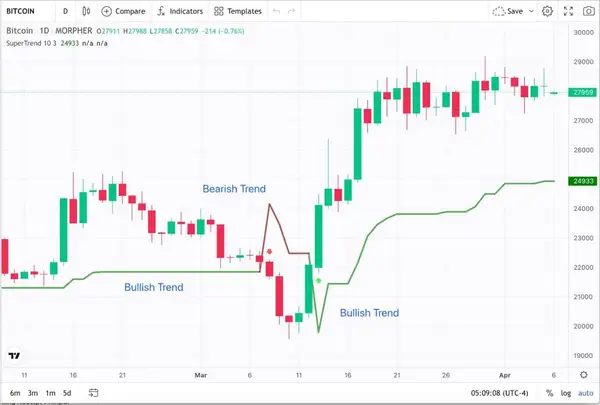
How to Set the Right Parameters for the Supertrend Indicator?
The choice of the parameters depends on the trading strategy and the trader's objectives. The Supertrend Indicator doesn't stand alone; it's a concoction of two vital values:
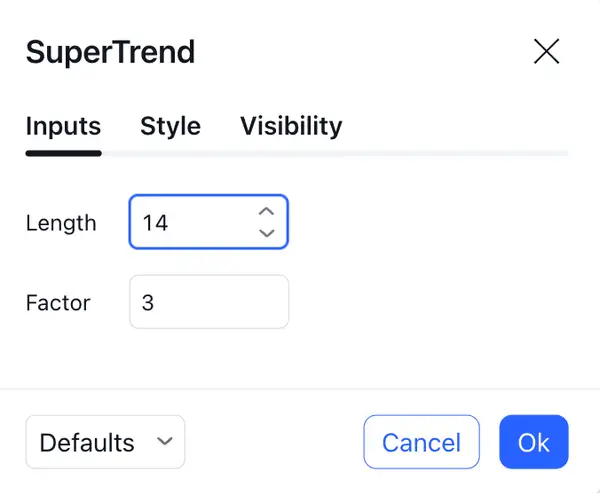
- Average True Range (ATR) or Length: The ATR serves as a gauge to measure the volatility of an asset. In essence, it offers a perspective on the range of price fluctuations. Choosing the right timeframe is also important when setting the parameters of the indicator.
- Short-Term Traders: Might opt for a shorter timeframe to quickly adapt to market conditions.
- Long-Term Traders: Might prefer a longer timeframe to get a more stable measure of volatility and to avoid getting whipsawed by short-term price spikes.
- Standard Setting: The most common default setting for ATR in many charting platforms is 14 periods, be it daily, hourly, or any other timeframe. This setting provides a balance, making it versatile enough for both short-term and medium-term trading.
- Multiplier or Factor: Acting as an offset, the multiplier determines the distance between the indicator and the price. The multiplier in the Supertrend Indicator affects how close or far the indicator is from the price. Think of it as an “adjustable buffer.” By manipulating the multiplier.

If you increase the multiplier, the Supertrend line will move further away from the price, creating a wider buffer. This means that the price will have to move more significantly to trigger a trend change in the Supertrend Indicator. In essence, you'll get fewer trend change signals, but they might be more reliable as they consider greater price movements. So, an increase leads to a wider gap between the indicator and the price, yielding fewer signals.
Decreasing the multiplier brings the Supertrend line closer to the price, narrowing the buffer. As a result, even slight price fluctuations might cause the Supertrend Indicator to signal a trend change. This leads to more frequent signals, but they can be prone to more false alarms due to the sensitivity to minor price movements. So, a decrease narrows the distance, resulting in a more frequent generation of signals.
Spotting the Buy and Sell Signals
Navigating the market becomes less daunting with the Supertrend Indicator's clear signals:
Buy Signal: A bullish trend is in the air when the price floats above the Supertrend Indicator.
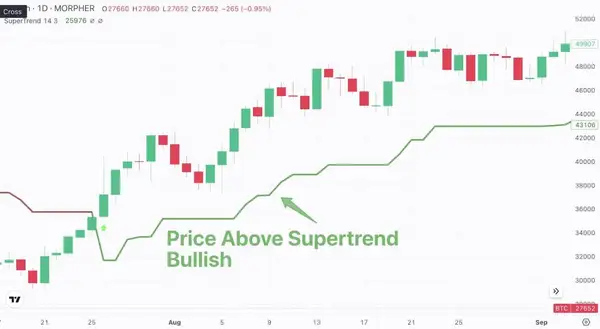
Sell Signal: On the flip side, a bearish ambience is suggested when the price dwells below the indicator.
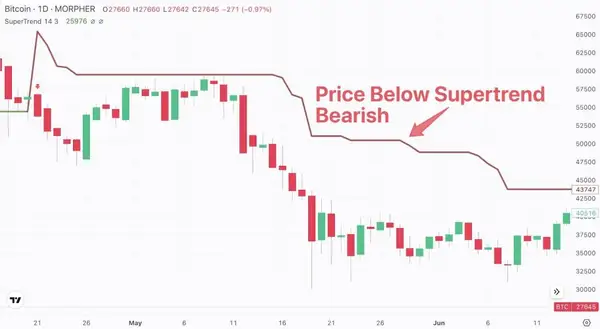
Supertrend Strategy Ideas
Now, it's pivotal to note the following three strategies we delved into are not just abstract theories. While we will provide specific chart examples to illustrate our points, these strategies can be applied to any type of investment, be it stocks, commodities, cryptocurrencies, or indices that can be adopted for any asset you're keen on. Think of the charts we'll show as a reference guide, but always remember that the core principles are universally applicable.
Also, in case you are not quite familiar with other indicators or concepts, simply click on the links and you will be guided to other great articles explaining the concepts in more detail.
Supertrend with Support and Resistance
In our analysis of Tesla's chart using the SuperTrend Indicator, we aim to capitalize on long trade opportunities by combining the strength of support levels and the RSI as a confirmation tool.
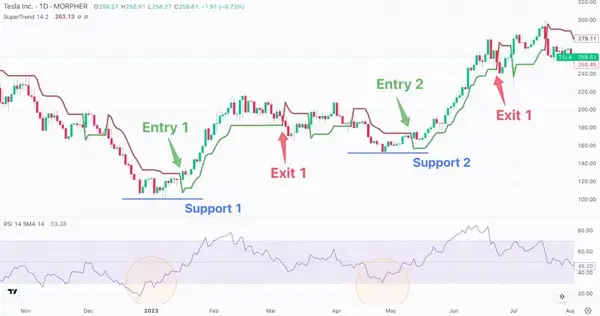
Let’s show the strategy that is playing out in the chart above:
- Identify Potential Support Levels: Begin by marking potential support levels on the chart. For Tesla, we observed a notable support level at around $100. Another support level was found at around $155.
- RSI Confirmation: Once a support level is identified, monitor the RSI for further confirmation. Ideally, we want the RSI to hover around the 30 mark, suggesting potentially oversold conditions. It's essential not just to look for the RSI value but also to wait until the RSI starts showing signs of upward reversal. This further solidifies the notion that the price might be bouncing off the support level.
- SuperTrend Entry Signal: With the support level and RSI conditions met, the final confirmation comes from the SuperTrend Indicator. Using a 14, 2 setting (which is more sensitive and thus provides more signals), enter the trade once the SuperTrend turns green.
- Trade Exit Strategy: Continue holding the position until the SuperTrend turns red, signalling a potential trend reversal or slowdown.
In our analysis:
- Trade 1: Based on the above criteria, we initiated a long trade near the first support level at approximately $127. The trade was exited when the SuperTrend turned red, with the price around $183. This generated a 44% return on the trade.
- Trade 2: Observing a similar setup at the second support level, a trade was taken from $173, and it was closed around $245, yielding a 41% return.
Note: It's vital to point out that although the SuperTrend did provide a reversal signal between Support 1 and Support 2, we chose not to act on it. This decision was based on the RSI, which did not show any signs of being at the lower end of its range, indicating that the potential trade did not meet all the criteria of our strategy. This showcases the importance of combining multiple indicators to filter out false signals and strengthen the decision-making process.
Supertrend and Momentum Indicators
In this strategy, we're exploring short opportunities on MARA's chart by combining the SuperTrend Indicator with key momentum indicators: RSI and MACD. Given the 14,1 setting for the SuperTrend Indicator, it will stay relatively close to the price, offering more precise signals.
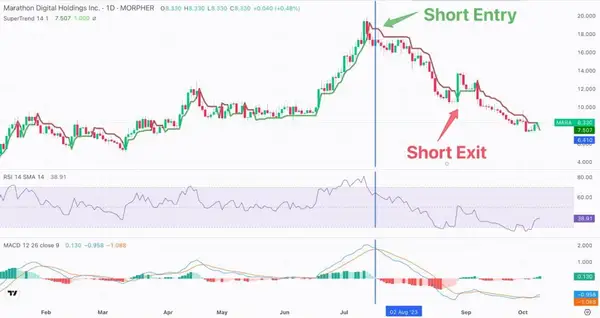
Let's break down this short-selling strategy that you can see play out in the chart above:
- SuperTrend as the Initial Trigger: Begin by watching for the SuperTrend to turn red. A red SuperTrend often indicates a potential downtrend.
- RSI Overbought Confirmation: With the SuperTrend turning red, shift your attention to the RSI. For a short opportunity, we need the RSI to read above 70, which indicates that the asset is potentially overbought. An RSI that was previously in the overbought zone and is starting to move downwards provides even more conviction that the price might be ready for a pullback.
- MACD Confirmation and Entry Point: Now, while the SuperTrend and RSI have set the stage, the MACD gives us our entry cue:
- Watch the MACD histogram (the bars). When the green bars start decreasing in size, it suggests a loss of upward momentum.
- The MACD consists of two lines: a fast line (often blue) and a slow line (often orange). The fast line is the difference between short-term and long-term moving averages, while the slow line is a smoothed version of the fast line. When the fast (blue) line crosses below the slow (orange) line, and the histogram bars turn red, it confirms a bearish momentum, which is our cue to enter the short trade.
- Trade Exit Strategy: The position is held until the SuperTrend turns green, signalling a potential trend reversal. Additional confirmation for an exit would be if the RSI moves below 30, indicating potential oversold conditions, suggesting that the downtrend might be losing steam and it's time to cover our short position.
In our analysis:
In this specific instance, after observing all the aligning indicators, we entered our short position at $18.5. Following our strategy, we exit the position at $11.8. This setup is highlighted by the blue line on the chart above, emphasizing the exact moment of entry and how the indicators aligned perfectly. Thus, by following this strategy, we achieved a return of approximately 36.22% on our short position.
This strategy emphasizes the importance of confluence. While the SuperTrend provides the overarching trend direction, the RSI offers insights into potential overbought (or oversold) conditions, and the MACD gives us precise entry (or exit) signals based on momentum shifts. By layering these indicators, we can filter out false signals and increase the likelihood of successful trades. Always remember to backtest strategies and use proper risk management techniques.
Supertrend and Candlestick Patterns
In this strategy, we combine the insights of the SuperTrend indicator with the powerful visual cues of candlestick patterns. Using the cryptocurrency Fantom as our trading asset, we aim to capitalize on the confluence of the SuperTrend's directional insight and the bullish implications of the Three White Soldiers pattern.
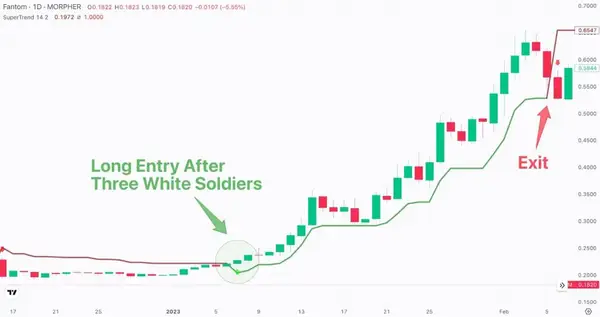
Historical Context: Observe the Fantom chart for a prolonged downtrend or sideways movement, ensuring there's ample historical context. This provides the necessary environment for a strong reversal pattern like the Three White Soldiers to form. The downtrend is indicated by the red colour of the SuperTrend indicator. In this case, it is set to 14,2.
Sideways Market Transition: As the downtrend exhausts, watch for a sideways market. During this phase, keep an eye on the SuperTrend indicator, which would typically oscillate between colours, suggesting indecision.
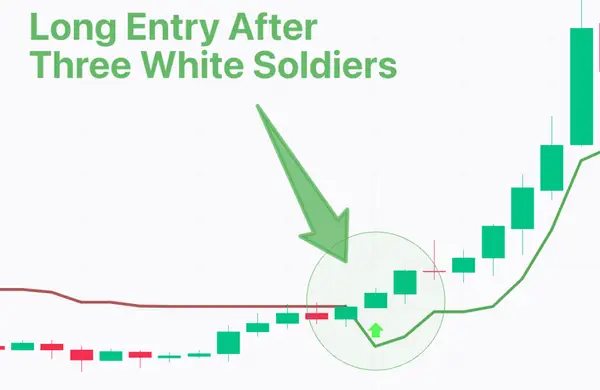
- SuperTrend as the Initial Trigger: Begin by watching for the SuperTrend to turn green from red. A red SuperTrend indicates a potential uptrend.
- Three White Soldiers Formation: On the 8th of January 2023, the chart presents the Three White Soldiers pattern (indicated by the green circle) —a trio of long bullish candles that typically follow a downtrend. Each of the candles opens within the previous candle's body and closes higher than the previous, symbolizing a strong shift in momentum. The third candle, in particular, boasts a commanding presence with no upper shadow, further indicating bullish confidence.
- Entry Point: In tandem with the formation of the Three White Soldiers, the SuperTrend indicator shifts from red to green, echoing the bullish sentiment and adding another layer of confirmation. Hence, we enter the trade right after we spot the Three White Soldiers Pattern at around $0.24
- Trade Exit Strategy: The position is held until the SuperTrend turns red, signalling a potential trend reversal. Additional confirmation for an exit would be if we spot a bearish candlestick formation, suggesting that the uptrend might be losing steam and it's time to exit our long position. In this case, the supertrend indicator turns red at around $0.527 where we exit the trade.
In our analysis:
This trade would have yielded an impressive return of approximately 120%. However, for risk management, setting a stop-loss around $0.200 is advised, ensuring minimal loss if the bullish reversal doesn't hold.
Merging the SuperTrend indicator with the insights of candlestick patterns can offer traders a dual layer of confirmation, maximizing the potential for success while minimizing unnecessary risk.
Conclusion
The SuperTrend Indicator, as we've explored, is a potent tool in trading. Its power is further enhanced when combined with other technical strategies, be it support and resistance levels, momentum indicators, or insightful candlestick patterns.
In our study, we saw how these combined tools create a more nuanced and accurate reading of market trends. They work in harmony. The SuperTrend defines the market's direction while the supplemental tools refine and validate its signals.
However, no tool is a silver bullet. It's essential for traders to practice and tailor these strategies, aligning them with their own trading style and risk comfort. Consistency in results comes from refining and iterating on your strategies. And for those who are just starting out and need a little extra guidance, we've even got a full updated guide that breaks it down in the simplest terms possible – “Candlestick Patterns: The Complete Guide”. There is no shame in starting at the beginning!
Also, while you are reading, we suggest always putting your new knowledge to the test. If you have a Tradingview premium account, try it there; if you do not, use Morpher. Why?
In the Tradingview free version, you can only save 2 templates, can only have 3 indicators and do not have after-hours / pre-market stock data. Morpher gives you unlimited data, unlimited layouts and unlimited indicator combos on one chart. On top of that, Morpher gives you candlesticks for markets you cannot find anywhere else, like luxury watches, sneakers, NFTs, and many more.
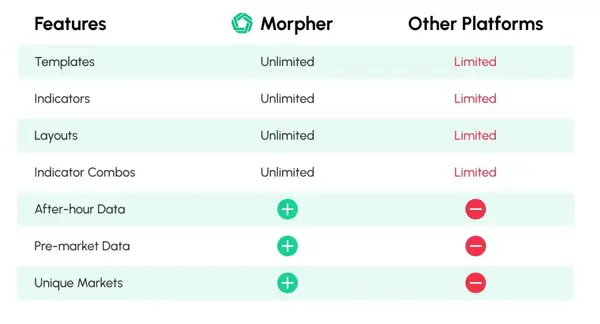
In summary, while the SuperTrend Indicator is a powerful standalone tool, its real potential shines when used in tandem with other strategies. Practice, customization, and platforms like Morpher are the keys to unlocking this potential. Now go on a hunt for a super trend and get some profits 🤑 Test now on Morpher.

Disclaimer: All investments involve risk, and the past performance of a security, industry, sector, market, financial product, trading strategy, or individual’s trading does not guarantee future results or returns. Investors are fully responsible for any investment decisions they make. Such decisions should be based solely on an evaluation of their financial circumstances, investment objectives, risk tolerance, and liquidity needs. This post does not constitute investment advice.

Painless trading for everyone
Hundreds of markets all in one place - Apple, Bitcoin, Gold, Watches, NFTs, Sneakers and so much more.

Painless trading for everyone
Hundreds of markets all in one place - Apple, Bitcoin, Gold, Watches, NFTs, Sneakers and so much more.


